Effect of Cold-Rolling Directions on Recrystallization Texture Evolution of Pure Iron
Abstract
:1. Introduction
2. Materials and Methods
3. Results and Discussion
3.1. Analysis of Cold-Rolled Sheets
3.1.1. Microstructural Features of Cold-Rolled Sheets
3.1.2. Features of Rolling Texture
3.2. Texture Analysis of Annealed Sheets
- (1)
- Recrystallized ferrite grains with Goss orientation, primarily nucleated in regions with high KAM value.
- (2)
- In the cold-rolled specimen, the nucleation sites of recrystallized ferrite grains with Goss orientation coincided with the region of non-recrystallized ferrite grains with γ-fiber and the interface between γ-fiber and α-fiber.
4. Conclusions
- (1)
- The development of γ-fiber and {100}<011> orientation was observed in both cold-rolled specimens. Furthermore, γ-fiber formed comparatively more in specimen A, while α-fiber developed comparatively more in specimen B.
- (2)
- The strain distribution in cold-rolled specimen A was presumably inhomogeneous, whereas it was rather uniform at the macro-scale in cold-rolled specimen B.
- (3)
- In the case of annealed specimen A, the formation of γ-fiber was confirmed. In annealed specimen B, however, the recrystallization texture tended to be random, and the formation of α-fiber was observed. The randomization of the recrystallization texture was attributed to the uniform strain distribution in cold-rolled specimen B. Furthermore, the formation of α-fiber in cold-rolled specimen B was attributed to continuous recrystallization from severely strained α-fiber.
- (4)
- The formation of Goss orientation was established in both specimens. Recrystallized ferrite grains with Goss orientation nucleated in high strain regions of cold-rolled specimen.
Author Contributions
Funding
Institutional Review Board Statement
Informed Consent Statement
Data Availability Statement
Conflicts of Interest
References
- Yoshinaga, N.; Sugiura, N.; Hiwatashi, S. A novel texture improving young’s modulus in rolling direction of hot rolled low carbon sheet steel. ISIJ Int. 2017, 57, 2263–2265. [Google Scholar] [CrossRef] [Green Version]
- Han, D.; Xu, Y.; Zhang, J.; Peng, F.; Sun, W. Relationship between crystallographic orientation, microstructure characteristic and mechanical properties in cold-rolled 3.5Mn TRIP steel. Mater. Sci. Eng. A 2021, 821, 141625. [Google Scholar] [CrossRef]
- Wang, Y.P.; Song, H.Y.; An, L.Z.; Wang, G.D.; Liu, H.T. Correlations between initial goss orientations with different deviation angles and evolution of microstructure and texture in ultrathin grain-oriented silicon steels. Steel Res. Int. 2021, 92, 2000356. [Google Scholar] [CrossRef]
- Senuma, T.; Kameda, M. Influence of cold rolling reduction and grain refinement of hot bands on planer anisotropy of r-value of cold rolled plain extra low carbon steel sheets. Tetsu-to-Hagané 1996, 82, 870–875. [Google Scholar] [CrossRef]
- Ray, R.K.; Jonas, J.J.; Hook, R.E. Cold rolling and annealing textures in low carbon and extra low carbon steels. Int. Mater. Rev. 1994, 39, 129–172. [Google Scholar] [CrossRef]
- Matsudo, K.; Shimomura, T.; Nozoe, O. Effect of carbide size, cold reduction and heating rate in annealing on deep-drawability of low-carbon, capped cold-rolled steel sheet. Texture Cryst. Solids 1978, 3, 53–72. [Google Scholar] [CrossRef] [Green Version]
- Tomita, M.; Inaguma, T.; Sakamoto, H.; Ushioda, K. Development of recrystallization texture in severely cold-rolled pure iron. ISIJ Int. 2016, 56, 693–699. [Google Scholar] [CrossRef] [Green Version]
- Yoshinaga, N.; Sugiura, N.; Hiwatashi, S.; Ushioda, K.; Kada, O. Deep drawability of electro-deposited pure iron having an extremely sharp <111>//ND texture. ISIJ Int. 2008, 48, 667–670. [Google Scholar] [CrossRef]
- Ogawa, T.; Sato, K.; Dannoshita, H.; Maruoka, K.; Ushioda, K. Role of Nb on microstructural evolution during intercritical annealing in low-carbon steels. ISIJ Int. 2016, 56, 2290–2297. [Google Scholar] [CrossRef] [Green Version]
- Fujita, T.; Nakamura, N.; Urabe, T.; Okuda, K.; Hosoya, Y. Effect of microstructure prior to cold-rolling on planar anisotropy of r-value in cold-rolled high carbon steel sheets. J. Jpn. Inst. Metals 2004, 68, 568–576. [Google Scholar] [CrossRef]
- Nave, M.D.; Barnett, M.R.; Beladi, H. The influence of solute carbon in cold-rolled steels on shear band formation and recrystallization texture. ISIJ Int. 2008, 44, 1072–1078. [Google Scholar] [CrossRef]
- Okai, D.; Yae, M.; Yamamoto, A.; Doi, T. EBSD observation of pure iron with near-cube orientation fabricated by cold rolling and annealing. Mater. Trans. 2017, 58, 838–841. [Google Scholar] [CrossRef] [Green Version]
- Gobernado, P.; Petrov, R.H.; Kestens, L.A.I. Recrystallized {311}<136> orientation in ferrite steels. Scripta Mater. 2012, 66, 623–626. [Google Scholar] [CrossRef]
- Sanjari, M.; He, Y.; Hilinski, E.J.; Yue, S.; Kestens, L.A.I. Texture evolution during skew cold rolling and annealing of a non-oriented electrical steel containing 0.9 wt% silicon. J. Mater. Sci. 2017, 52, 3281–3300. [Google Scholar] [CrossRef]
- Sugiyama, S.; Ogawa, T.; He, L.; Wang, Z.; Adachi, Y. Quantitative analysis of the recovery process in pure iron using X-ray diffraction line profile analysis. Materials 2021, 14, 895. [Google Scholar] [CrossRef]
- Ogawa, T.; Maruyama, N.; Sugiura, N.; Yoshinaga, N. Incomplete recrystallization and subsequent microstructural evolution during intercritical annealing in cold-rolled low carbon steels. ISIJ Int. 2010, 50, 469–475. [Google Scholar] [CrossRef] [Green Version]
- Umezaki, S.; Murata, Y.; Nomura, K.; Kubushiro, K. Quantitative analysis of dislocation density in an austenitic steel after plastic deformation. J. Jpn. Inst. Met. Mater. 2014, 78, 218–224. [Google Scholar] [CrossRef] [Green Version]
- Hashimoto, N.; Yoshinaga, N.; Senuma, T. Texture evolution of IF steel due to recrystallization. ISIJ Int. 1998, 38, 617–624. [Google Scholar] [CrossRef]
- Quadir, M.Z.; Duggan, B.J. Deformation banding and recrystallization of α fibre components in heavily rolled IF steel. Acta Mater. 2004, 52, 4011–4021. [Google Scholar] [CrossRef]
- Abe, M.; Kokabu, Y.; Hayashi, Y.; Hayami, S. Effect of grain boundaries on the cold rolling and annealing textures of pure iron. Trans. Jpn. Inst. Metals 1982, 23, 718–725. [Google Scholar] [CrossRef] [Green Version]
- Ushioda, K.; Hutchinson, W.B. Role of shear bands in annealing texture formation in 3%Si–Fe(111)[112] single crystals. ISIJ Int. 1989, 29, 862–867. [Google Scholar] [CrossRef] [Green Version]
- Barnett, M.R.; Jonas, J.J. Influence of ferrite rolling temperature on microstructure and texture in deformed low C and IF steels. ISIJ Int. 1997, 37, 697–705. [Google Scholar] [CrossRef]
- Atake, M.; Barnett, M.R.; Hutchinson, B.; Ushioda, K. Warm deformation and annealing behaviour of iron-silicon-(carbon) steel sheets. Acta Mater. 2015, 96, 410–419. [Google Scholar] [CrossRef]
- Nakanishi, S.; Morikawa, T.; Higashida, K.; Murakami, H.; Kimura, K.; Ushioda, K. Effect of solute carbon content on microstructures of cold-rolled ferritic steel-The same area analyses by using TEM and SEM-EBSD-. Tetsu-to-Hagané 2012, 98, 253–261. [Google Scholar] [CrossRef] [Green Version]
- Ogawa, T.; Sugiura, N.; Maruyama, N.; Yoshinaga, N. Influence of state of Nb on recrystallization temperature during annealing in cold-rolled low-carbon steels. Mater. Sci. Eng. A 2013, 564, 42–45. [Google Scholar] [CrossRef]
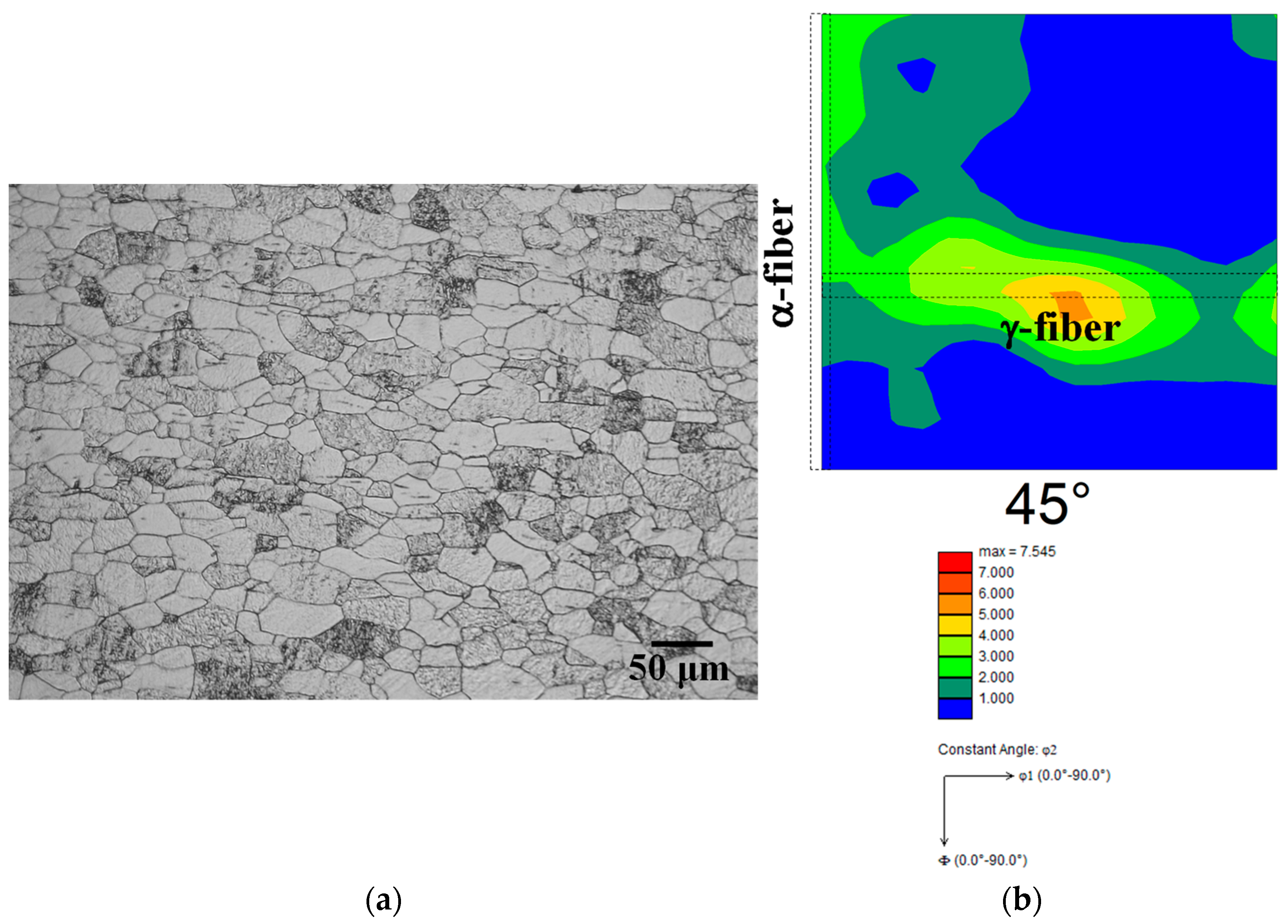
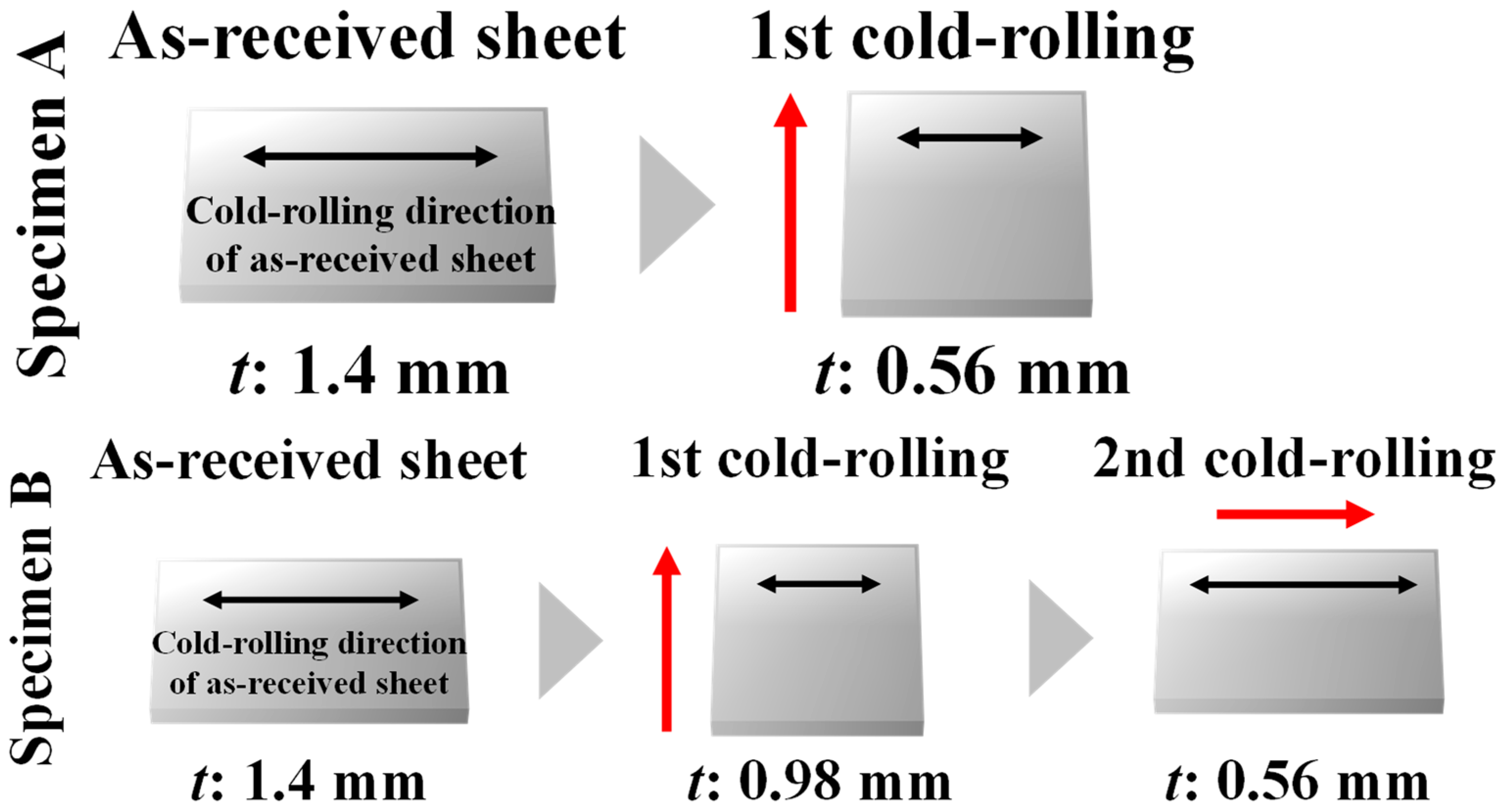

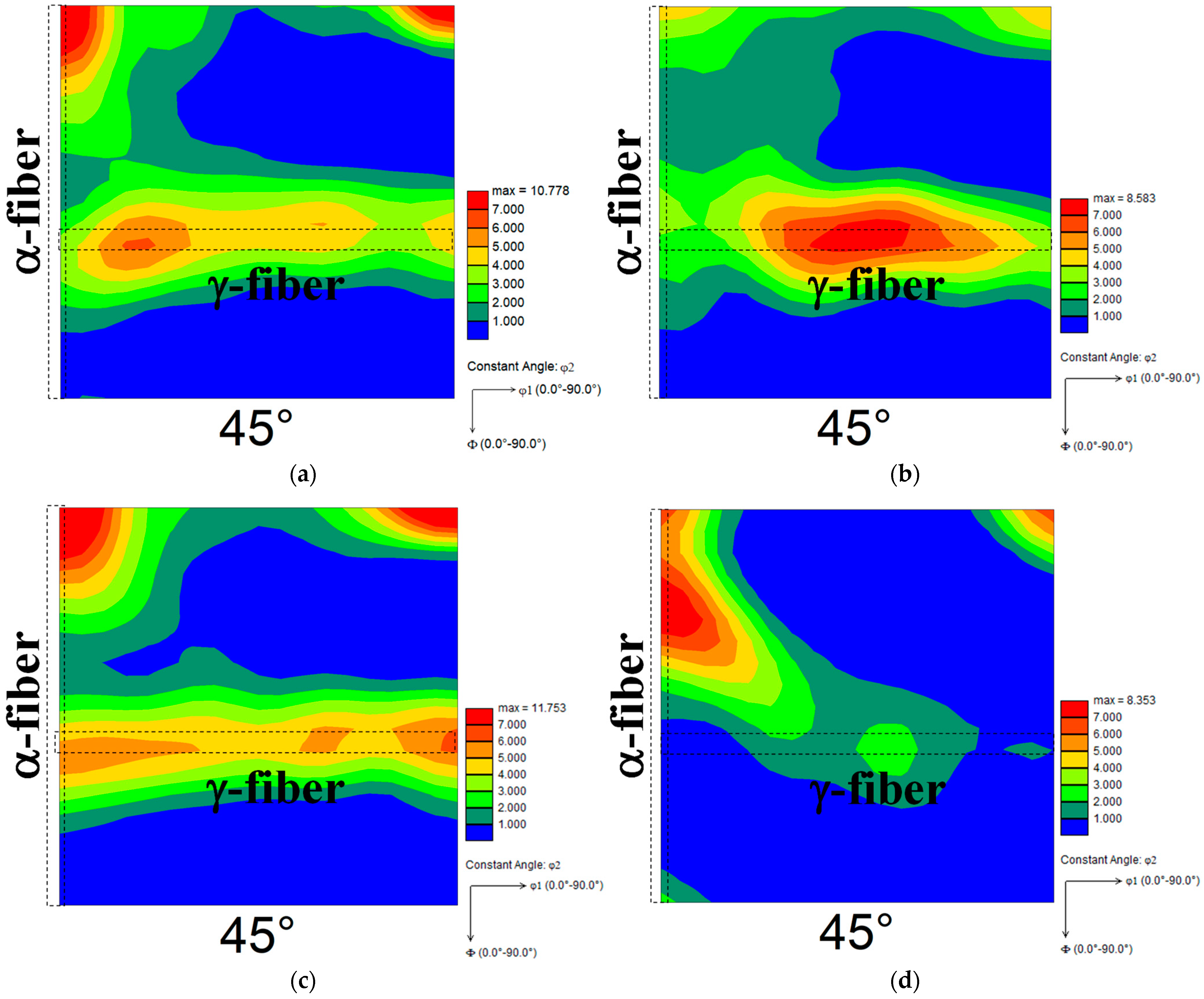
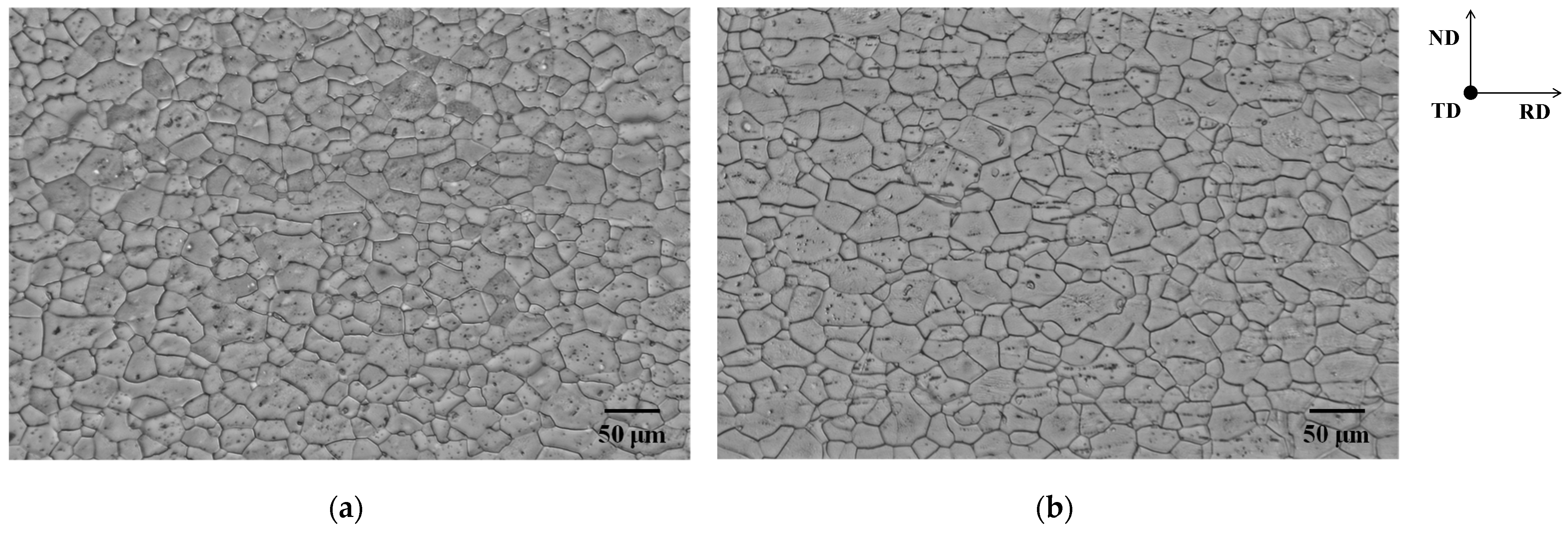


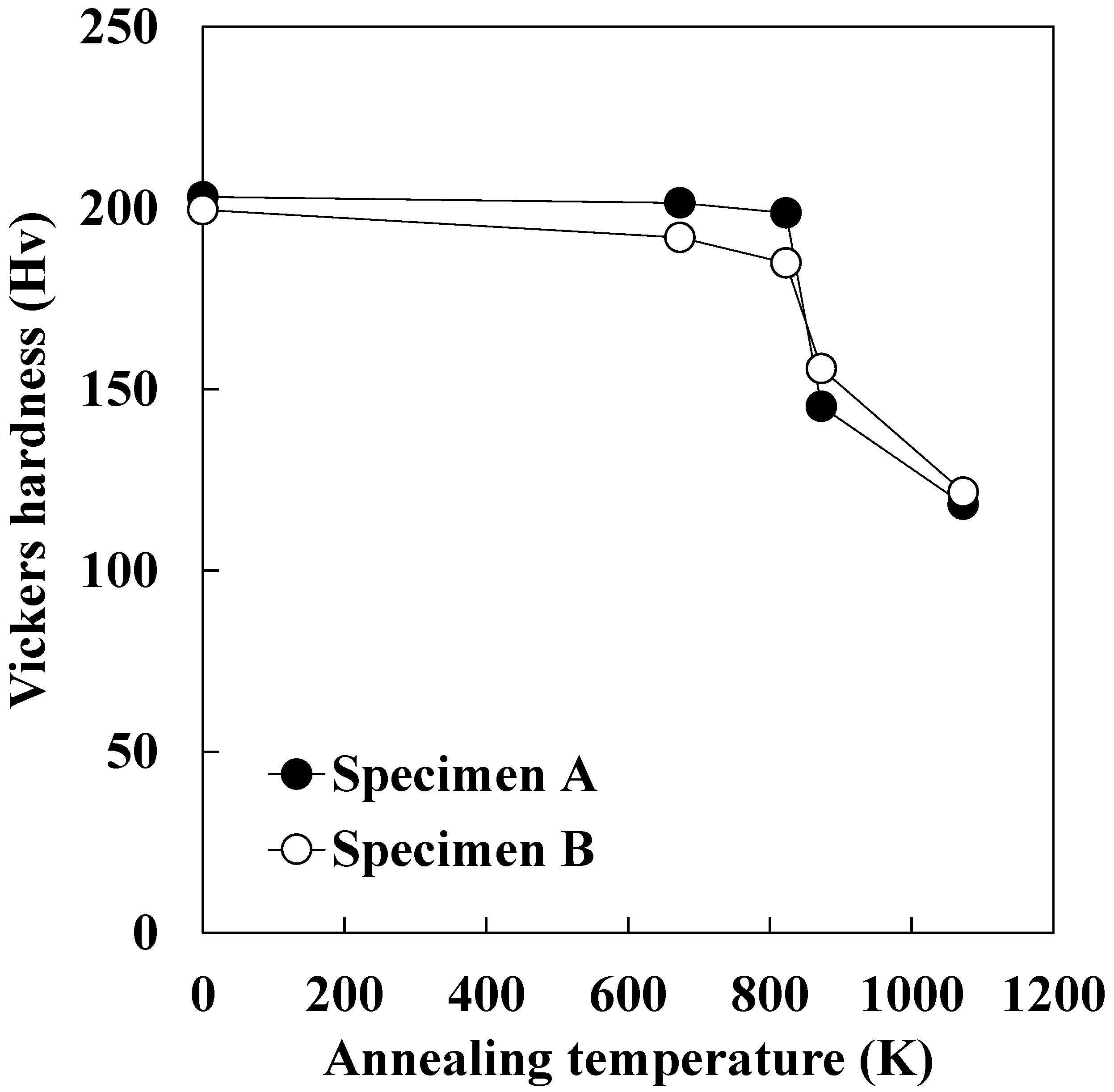

Publisher’s Note: MDPI stays neutral with regard to jurisdictional claims in published maps and institutional affiliations. |
© 2022 by the authors. Licensee MDPI, Basel, Switzerland. This article is an open access article distributed under the terms and conditions of the Creative Commons Attribution (CC BY) license (https://creativecommons.org/licenses/by/4.0/).
Share and Cite
Ogawa, T.; Suzuki, Y.; Adachi, Y.; Yamaguchi, A.; Matsubara, Y. Effect of Cold-Rolling Directions on Recrystallization Texture Evolution of Pure Iron. Materials 2022, 15, 3083. https://doi.org/10.3390/ma15093083
Ogawa T, Suzuki Y, Adachi Y, Yamaguchi A, Matsubara Y. Effect of Cold-Rolling Directions on Recrystallization Texture Evolution of Pure Iron. Materials. 2022; 15(9):3083. https://doi.org/10.3390/ma15093083
Chicago/Turabian StyleOgawa, Toshio, Yutaro Suzuki, Yoshitaka Adachi, Atsushi Yamaguchi, and Yukihiro Matsubara. 2022. "Effect of Cold-Rolling Directions on Recrystallization Texture Evolution of Pure Iron" Materials 15, no. 9: 3083. https://doi.org/10.3390/ma15093083
APA StyleOgawa, T., Suzuki, Y., Adachi, Y., Yamaguchi, A., & Matsubara, Y. (2022). Effect of Cold-Rolling Directions on Recrystallization Texture Evolution of Pure Iron. Materials, 15(9), 3083. https://doi.org/10.3390/ma15093083






